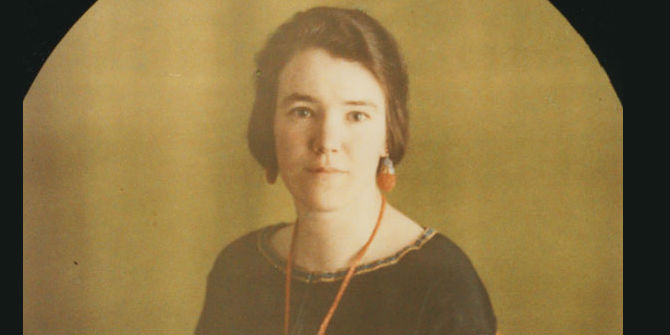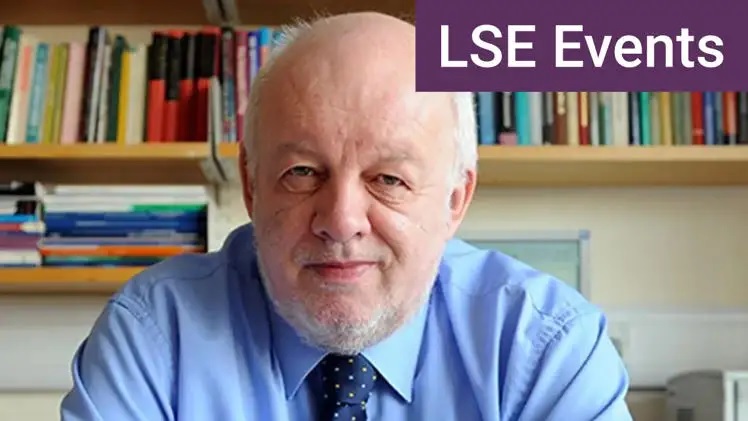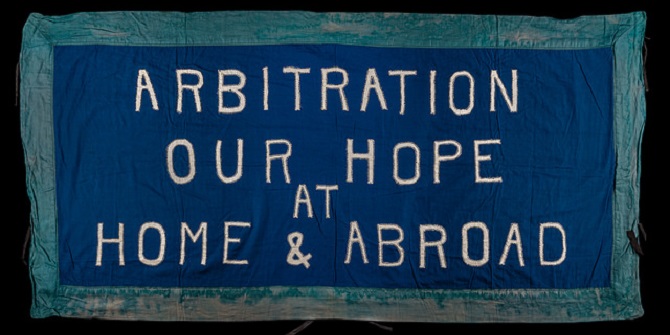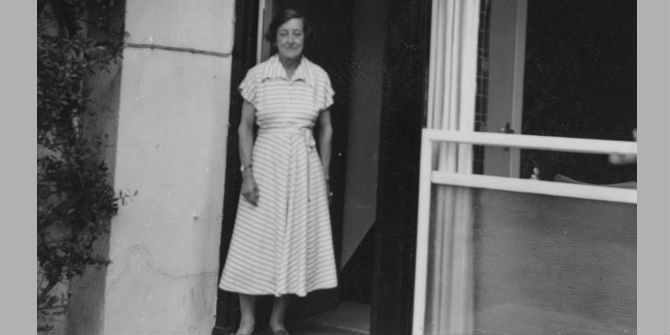Jennie Stayner introduces pioneering female academic Lilian Knowles, first female professor of Economic History at LSE, and first female Dean of Faculty in the University of London.
Intentionally or unintentionally, it seemed to be her lot to be breaking down barriers.
C M Knowles
Lilian Charlotte Anne Knowles (Tomn) was born in 1870 in Cornwall and spent a happy childhood riding horses and winning first prizes at Truro High School “with startling hats and unshrinking self-confidence…”[1].
At Cambridge she achieved a double first in History and Law coming ‘equal to 2’ in the Law Tripos Part 1 in 1894. She delighted in telling the story of her viva in which she responded to the three ancient lawyers’ question of what her name was with ‘Tomn, t-o-m-n, as in damn”.[2] Graham Wallas wrote in her obituary in Economica that “…all the best stories about her came from herself, though no-one who knew her doubted their truth.”[3] She was a straight-talker who did not suffer fools and certainly pulled no punches in some of the letters the LSE has in her file. Describing an academic colleague as “that terrible American” for example.

Knowles joined LSE in 1895 as a research student and became a permanent lecturer in Economic History in 1904. In 1907 she was promoted to Reader and in 1921 became the first Professor of Economic History at LSE (and the second professor of EH in the country). She was the first female Dean of Faculty in the University of London, holding the position of Dean of the Faculty of Economics from 1920 to 1924. Sir William Beveridge described her as “for many years one of its [LSE] most powerful personalities. She is thus among the makers as well as one of the earliest inhabitants of the School of Economics.”[4]
Alongside academia, Knowles held several public appointments. In 1918 she worked in a committee to discover changes in the cost of living for the working classes. In 1919 she was the only female member of the Royal Commission on Income Tax and focussed especially on, in her view, the unfair practice of charging tax on the joint income of married couples. She was also a member of council of both the Royal Economic Society and the Royal Historical Society.
Throughout her life and career she was a pioneer for women, not politically but through her actions, and she advanced her gender by example. Her husband C M Knowles, writing her biography for her posthumously-published second volume on the Economic Development of the British Empire, described her incredible achievements alongside a lack of desire to be involved in political action:
An ardent supporter of any movement that made for equality of opportunity as between men and women, she marched in no suffragette processions, still less did she intend to go to gaol for her principles, although she would cheerfully have done both had she thought any good purpose would have been served thereby. But she held that she was doing more good to the cause by showing that she, a woman, could do a man’s job as well as any male creature and better than most. [5]
Her example as the first female professor of Economic History at LSE, the first female Dean of Faculty in the University of London, and her public work is an exceptional one, peppered with personal achievements which impacted on society in general. In 1904 for instance, she married but she did not give up work. “Believing, presumably, that example teaches better than precept, she constituted herself an illustration of the doctrine which she steadily upheld, that the mere fact of marriage ought not to disqualify a woman from pursuing any career for which she is otherwise fitted.”[6] In fact, she was promoted in 1907 and “regarded her marriage as nobody’s concern but her own, and she merely intimated her change of personal status in order that her change of name might be noted for the purpose of the University records and the School of Economics syllabuses.”[7]
She advocated appropriate pay and, when addressing a group of women, called for collective responsibility to not take a lower rate of pay than the going rate. This was because that action would undercut the labour market and make it difficult for those who could not subsidise their income through family generosity. She is quoted as saying:
Whatever work women take up they must be careful, if it is paid work, not to take less than the market rate because they happen to be well off… Better unpaid work than inadequately paid work. [8]
More revolutionary still, she advocated equal pay and “…consistently throughout her career refused to take less than a man’s pay because she happened to be a woman.”[9] There is a letter in her file to the director from 1911 describing the work she has done to assist students with exam revision and her claim for payment, stating “I base my claim … on the ordinary hours as compared with [fellow tutor and man] Cannan…”[10]
Despite her lack of political action, her experience speaks for itself and the following description of her principles rings of an early feminism. Her staff file notes that “She was intensely loyal by nature, loyal to her friends, loyal to her university, loyal to her sex, and no amount of flattery had any charm for her when it took the form of holding her up as the exception among women who proved the rule of their general inferiority and so made her the instrument of an attack on her own sex.”[11]
As an LSE teacher, Lilian Knowles supported and pushed her students with a zeal and sometimes an extremely strong shove. She was dedicated to students and knew each one as an individual. After her death Sir William Beveridge, then Director of LSE, described how “to one generation of students after another…Mrs Knowles more than any other person represented the School, not as an institution and a seat of formal learning, but as a place of human relations and emotions and mutual helpfulness.”
It is therefore highly appropriate that she gives her name to not only a hall of residence, but to two student prizes in the Department of Economic History: those for the best set of marks in the first year and the final year of the Department’s Undergraduate degree programmes.
This pioneering woman’s portrait hangs in the Department of Economic History on the fifth floor of Sardinia House.

References
[1] Wallas, Graham, “Lillian Knowles”, Economica
[2] ibid
[3] ibid
[4] Beveridge, William, “Lillian Knowles”, Economica
[5] Knowles, CM, “Professor Lilian Knowles: A Memoir” in The Economic Development of the British Overseas Empire vol. 2, Routledge, London, 1930
[6] ibid
[7] ibid
[8] ibid
[9] ibid
[10] LSE Staff File, Lilian Knowles
[11] ibid





